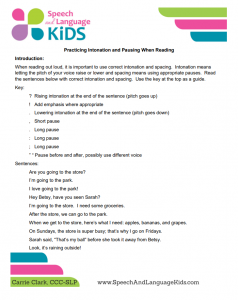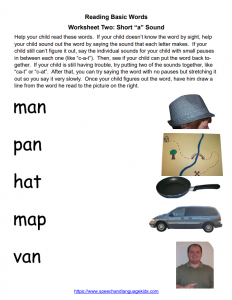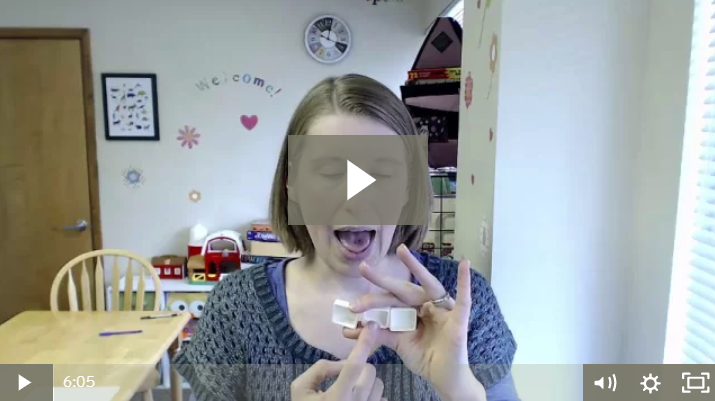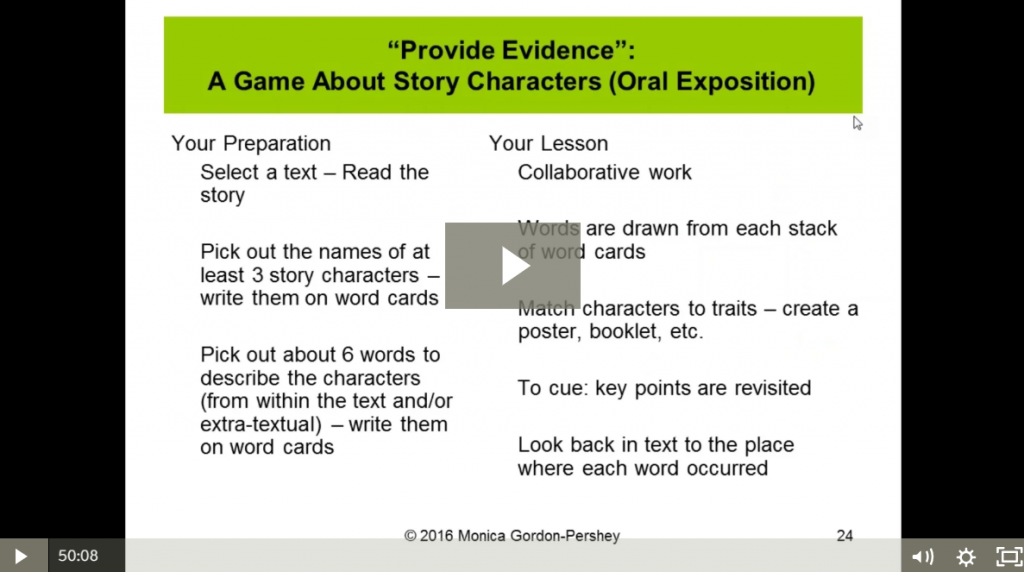Condition: Reading Fluency Problems
Jump To:
Norms by Age Evaluation Suggested Goals Therapy
Definition:
What is Reading Fluency?
Reading fluency is made up of accuracy, rate, and prosody:
Fluent reading comprises three key elements:accurate reading of connected text at a conversational rate with appropriate prosody or expression (Hudson, Mercer, & Lane, 2000). A fluent reader can maintain this performance for long periods of time, can retain the skill after long periods of no practice, and can generalize across texts. A fluent reader is also not easily distracted and reads in an effortless, flowing manner.
Why Does it Matter?
The most compelling reason to focus instructional efforts on students becoming fluent readers is the strong correlation between reading fluency and reading comprehension (Allington, 1983; Johns, 1993; Samuels, 1988; Schreiber, 1980). Each aspect of fluency has a clear connection to text comprehension. Without accurate word reading, the reader will have no access to the author’s intended meaning, and inaccurate word reading can lead to misinterpretations of the text. Poor automaticity in word reading or slow, laborious movement through the text taxes the reader’s capacity to construct an ongoing interpretation of the text. Poor prosody can lead to confusion through inappropriate or meaningless groupings of words or
through inappropriate applications of expression.
Hudson, R.F., Lane, H.B., & Pullen, P.C. (2005). Reading fluency assessment and instruction: What, why, and how?
https://www.fcrr.org/publications/publicationspdffiles/hudson_lane_pullen_readingfluency_2005.pdf
Developmental Norms:
Here are some things to look for when it comes to reading fluency at different ages:
- Preschool/Kindergarten: In preschool and kindergarten, children who are at risk for reading disorders are likely to exhibit difficulty with phonological awareness and phonics (Torgensen, 2002, 2004). This problem may continue as they struggle to develop the skills they need for accurate and fluent word recognition. (Source)
- Early Elementary School: Red Flag for Reading Problems: Does not read smoothly without frequent pausing (i.e., impaired reading fluency) (Source)
- Later Elementary Level and Above: Red Flag for Reading Problems: Has weak reading decoding skills (may impact reading fluency and reading comprehension) (Source)
2017 Oral Reading Fluency Data by Hasbrouck and Tindal
Students scoring 10 or more words below the 50th percentile using the average score of two unpracticed readings from grade-level materials may need a fluency-building program.
(Source: https://www.readingrockets.org/article/fluency-norms-chart-2017-update)
| Grade | %ile | Fall WCPM* | Winter WCPM* | Spring WCPM* |
|---|---|---|---|---|
| 1 | 90 | 97 | 116 | |
| 75 | 59 | 91 | ||
| 50 | 29 | 60 | ||
| 25 | 16 | 34 | ||
| 10 | 9 | 18 | ||
| 2 | 90 | 111 | 131 | 148 |
| 75 | 84 | 109 | 124 | |
| 50 | 50 | 84 | 100 | |
| 25 | 36 | 59 | 72 | |
| 10 | 23 | 35 | 43 | |
| 3 | 90 | 134 | 161 | 166 |
| 75 | 104 | 137 | 139 | |
| 50 | 83 | 97 | 112 | |
| 25 | 59 | 79 | 91 | |
| 10 | 40 | 62 | 63 | |
| 4 | 90 | 153 | 168 | 184 |
| 75 | 125 | 143 | 160 | |
| 50 | 94 | 120 | 133 | |
| 25 | 75 | 95 | 105 | |
| 10 | 60 | 71 | 83 | |
| 5 | 90 | 179 | 183 | 195 |
| 75 | 153 | 160 | 169 | |
| 50 | 121 | 133 | 146 | |
| 25 | 87 | 109 | 119 | |
| 10 | 64 | 84 | 102 | |
| 6 | 90 | 185 | 195 | 204 |
| 75 | 159 | 166 | 173 | |
| 50 | 132 | 145 | 146 | |
| 25 | 112 | 116 | 122 | |
| 10 | 89 | 91 | 91 |
* WCPM = Words Correct Per Minute
The 2017 chart is available as a PDF: 2017 Hasbrouck & Tindal Oral Reading Norms
Evaluation:
Guidance from the American Speech-Language Hearing Association on assessment for literacy:
Both formal and informal assessment activities are used:
- Formal tests of written language may be administered by the SLP or another member of the special education team (e.g., special education teacher or reading specialist). When another member of the team administers the tests, the SLP works collaboratively to coordinate assessments and to interpret the collective results of formal and informal spoken and written language assessments. When possible, use measures of oral and written language that have been co-normed on the same standardization samples so that their results may be compared directly. This allows for a more integrated approach to the assessment of language and literacy skills (Nelson, 2014b; Nelson et al., 2015).
- Informal activities can include strategic observations of students engaged in literacy activities and assessment of writing samples from curriculum-based activities. One advantage of informal curriculum-based assessment is that the SLP then can introduce scaffolding and instructional techniques to see how the student responds. These dynamic assessment techniques, which are not allowed during formal testing, can lead directly into intervention.
Publication with Information about assessing accuracy, rate, and prosody (Plus Lists of Formal Assessments):
Hudson, R.F., Lane, H.B., & Pullen, P.C. (2005). Reading fluency assessment and instruction: What, why, and how?
https://www.fcrr.org/publications/publicationspdffiles/hudson_lane_pullen_readingfluency_2005.pdf
Suggested Goals:
The results of the assessment process should help guide what you will target in therapy for a child with reading fluency problems. Here are some goals that you may be addressing with this population. You can click on one of the goals below to learn more. Or, scroll down to the therapy section for more in-depth resources and support for treating this condition.
Therapy:
Here are a few types of therapy activities that have been suggested for improving reading fluency. For more information, click this source: https://www.fcrr.org/publications/publicationspdffiles/hudson_lane_pullen_readingfluency_2005.pdf
- Repeated Readings: The repeated readings technique (Samuels, 1979) has many different approaches that vary in levels of support and emphasis on building speed. Repeated readings emphasizes practice as a way of working on all of the areas of reading fluency— accuracy, rate, and prosody—and is one of the most-studied methods for increasing reading fluency (Kuhn & Stahl, 2000; Meyer & Felton, 1999; NICHD, 2000).
- Readers Theatre: Readers Theatre is a popular method of reading practice that can be a powerful way to increase prosody. For Readers Theatre, the teacher creates scripts from selections of children’s literature that are rich in dialogue. Rehearsing and performing the play for peers provides an authentic purpose for rereading the text multiple times. Readers Theatre can help students develop accuracy, rate, and prosody.
- Self-recordings: For struggling readers, having the opportunity to record, listen, and rerecord can be a powerful method for increasing reading fluency.
- Calling the reader’s attention to phrase boundaries: Where you pause makes a difference
- Assisted reading methods: Echo reading and unison reading
- Explicit teaching of intonation using punctuation
Here are some more resources and information that may help you when it comes to treating this condition.
Other Resources and Materials for Working with Literacy Skills
Practicing Intonation and Pausing Using Punctuation
A one-page worksheet that will help with teaching reading prosody using punctuation.
Quick worksheet for practicing sight words with the short “a” sound.
Phonological Awareness Skills for Older Children
Help for children who are already reading but who seemed to have missed some skills in phonological awareness.
Language & Literacy Activities K-4 – Webinar Recording
An hour-long webinar recording with therapy activities and materials for working on language and literacy for classroom success of children in Kindergarten through grade four.
Didn’t Find What You’re Looking For?
We’re constantly working on adding new features and topics to this membership site. If you don’t find what you’re looking for by using the search bar at the top of the page, please use the button below to request new features or topics to be added!








